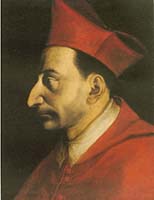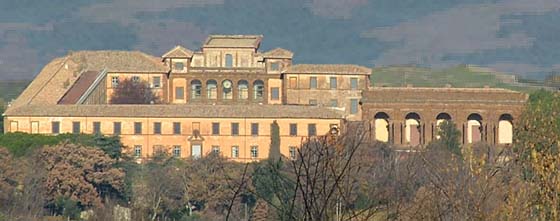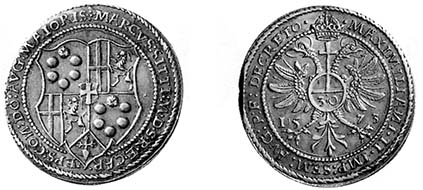1. Marcus Sitticus of Hohenems
The masters of Hohenems owed their rise to become the most important noble family in Vorarlberg to their loyalty to the House of Habsburg. Two family members in the service of the latter had died in the Battle of Sempach against the rebel Swiss peasants. For centuries to come then, many members of the House of Ems earned their living as vögte (reeves) of the House of Habsburg and as leaders of mercenaries in Germany and Northern Italy. The last and decisive push to their career, however, owed those of Ems not to royal power but to their own prudent marriage policy.
Wolf Dietrich of Ems (*1507, † 1538), vogt of Bludenz and Sonnenberg, married a female member of the Medici family in 1528 – albeit not stemming directly from the famous Florentine family. She was the sister of a colleague of Wolf Dietrich, a condottiere called Gian Giacomo Medici, Duke of Marignano. Six children were the product of this marriage that already ended in 1538 due to the untimely death of Wolf Dietrich.
Marcus Sitticus as condottiere.
Of special interest here is the second one of the six children, the second oldest son of Clara and Wolf Dietrich, Merk Sittich – or, as he was called in Latin, Marcus Sitticus. Already as a young man, he went to Italy where he earned his living for ten years as condottiere, like his father. The year 1559 saw the crucial change in the life of the young man: his maternal uncle, the jurist and protonotary Gian Angelo Medici, was elected Pope Pius IV by the Roman College of Cardinals.
Immediately, the then 27 year old Marcus Sitticus set forth for Rome. To the astonishment of all, he changed career on that occasion. The condottiere joined the clergy. A pleasant story tells us the reason for that: a heavenly sign had led Marcus Sitticus to abandon the art of warfare. He had fallen from a carriage in a traffic accident. Whereas he did not suffer any injuries, his epee was smashed.
Malicious tongues claimed that Marcus Sitticus did not take the minor orders because of the miracle but because of a wound that continually caused him trouble – in combination with the favourable prospects of the papal uncle’s patronage.
Portrait of Charles Borromeo by Ambrogio Figino.
The newly minted clergy man, however, had a serious opponent in his attempts to win his uncle’s favour. The latter not only had a sister that was married and lived in Germany but another one that had married into the Northern Italian Borromeo family. Her third son Charles was a talented young man who studied law in Pavia since 1552. Pope Pius IV called him to Rome – Marcus Sitticus, in contrast, he preferred to send away. As a consolation, he assigned him to bring a message to the House of Habsburg saying that the new Pope would break with the traditionally anti-imperial policy of his predecessors. Ferdinand I was so pleased with this news that he elevated the masters of Ems to the status of Hereditary Imperial Counts in April 27th, 1560. From that moment on, the brothers of Marcus Sitticus were no longer called of Ems but of Hohenems. For profitable benefices, however, he had to wait. Whereas his cousin Charles Borromeo became the new Archbishop of Milan, his own negotiations with the cathedral chapters of Cologne and Salzburg proved unsuccessful. Only the cathedral chapter of Constance, at the intercession of Hans Werner of Raitenau, agreed to elevate Marcus Sitticus to the rank of Bishop of Constance.
Therewith, Marcus Sitticus became the highest spiritual shepherd of this important diocese near the Lake Constance from where not only the Southern part of Germany but major parts of the Catholic cantons of the Confederation, too, were supervised. The church dignitary, however, who was more attached to earthly joys, visited his diocese three times only. Pius IV had something else in mind for his nephew. First, he sent him as his deputy to Trent where the Council was in session. There the former condottiere made a spectacle of himself because of his poor Latin skills and his lack of theological education. We know of a number of jokes about him. In Trent a pun was spreading that characterized the Council’s most important participants: of Cardinal Gonzaga, who was hard of hearing, it was said that he had not heard anything, the erudite but very cautious Seripando had not dare anything, the book lover Hosius had read all the time whereas the Council’s Secretary, Simonetta, had always been writing. In contrast, the master of Hohenems “does not hear anything, does not dare anything, does not read or write anything.” It was even implied that Marcus Sitticus still had to learn to say the Lord’s Prayer in Latin. The Council’s participants were more than glad to see Marcus Sitticus released from his theological responsibility by the Pope on October 22nd, 1562, to convey his congratulations to the new king of the Holy Roman Empire, Maximilian II.
The urban jokes about his insufficient Latin skills notwithstanding, Marcus Sitticus of Hohenems possessed great influence on the College of Cardinals whose member he was since 1563. He participated in seven papal elections and made sure that no pope hostile to him rose to power. On that occasion he even clashed with his later canonised cousin Charles Borromeo, Bishop of Milan. He prevented that Charles’ candidate, a very stern ascetic and man of the order, became pope.
After all, Marcus Sitticus was not fond of asceticism himself. He spent most of his revenues from the various churchly benefices on the luxury that the late Renaissance in Italy had to offer. His unattended diocese of Constance alone brought between 10 and 20.000 gold gulden every year. It seems safe to assume that the favourite of Pius IV had more than 40.000 gold gulden per year at his disposal. The method of how the cardinal “acquired” his means is made transparent in a letter he wrote to his brother Jacob Hannibal of Hohenems on October 6th, 1564. There Marcus Sitticus reports that an abbey “has become free that long had been in the possession of the House of Signor Julia Cesarino… That abbey I snapped. Although it is worth 6 or 7.000 crowns and Signor Juliano and his son have an annuity of 4.000 scudi on it, it is a good buy nonetheless. Since it is such a beautiful object being located on Italian ground and it is a good thing to bring it into the possession of a noble family.”
The Villa Mondragone.
Visitors of Rome and its environments with an interest of the history of art will thank Marcus Sitticus for his continuous efforts to collect money – and for his equally continuous and enthusiastic efforts to spend it on the promotion of the arts. One of his salaried employees, for example, was Torquato Tasso. In addition, the cardinal was a keen architect. The Villa Mondragone in the Alban Hills, where the Gregorian calendar reform was announced in 1582, was built for him. His spacious palazzo not far from the Piazza Navona impresses tourists up to the present day and his titular church Santa Maria in Trastevere owes him some important parts of its decoration.
The only thing Marcus Sitticus was interested in regarding his diocese of Constance was the gold gulden he could get out of it. Even though the bishops were obliged by the Roman official church to actually live in their diocese and even though the diocesan chapter of Constance as well as of the Catholic cantons of Switzerland complained about Marcus Sitticus at the papal court more than once, Marcus Sitticus nevertheless stayed away from his diocese.
Ferdinand II, Archduke of Austria, used that as an opportunity to push the absent bishop’s resignation. He had, after all, a son from his first (morganatic) marriage with Philippine Welser that had to be cared for. But Marcus Sitticus was very tough to negotiate with. It was only in 1589 that a contract was accomplished that brought the son of Ferdinand, Cardinal Andreas of Austria, the diocese of Constance. The master of Hohenems, on his part, saw to it that his resignation was lavishly remunerated. The new bishop had to pay 12.000 gold crowns – that is roughly 18.000 gulden – per year to his predecessor. Marcus Sitticus had even protected himself against the death of his successor with 40.000 gold crowns deposited in a secure place.
Marcus Sitticus, cardinal and former Bishop of Constance, died, gout-ridden, on February 15th, 1595, in Rome. His burial place, alongside with the one of his son Roberto, can be visited in Santa Maria in Trastevere in Rome.
CONSTANCE. Marcus Sitticus of Hohenems as Bishop of Constance 1561-1589. Gulden taler of 60 kreuzer, 1573. Crest, cardinal’s hat above. Rev. Haloed imperial eagle, on the chest imperial orb with the value number 60. Year 15-73. Berst. 405var. Museum zu Allerheiligen inv. N10651. From auction sale Leu Numismatik AG 73 (1998), 967.
CONSTANCE. Marcus Sitticus of Hohenems as Bischop of Constance 1561-1589. Half gulden taler of 30 Kreuzer, n.d. Crest. Rev. Haloed imperial eagle, on the chest imperial orb with the value number 30. Berst. 406. Museum zu Allerheiligen inv. N10652. From auction sale Leu Numismatik AG 73 (1998), 969.
The extremely rare coins minted in the name of Marcus Sitticus in Constance are, above all, representative in nature. On the obverse they show a crest assembled from the one of the Medici family (the so-called palle or balls), the one of the House of Hohenems (Capricorn), the one of the diocese of Constance (cross) and of the Abbbey of Reichenau (cross) plus the one of the chivalric Order of Santiago de Compostela (flame-bladed sword). Almost all pieces depict the cardinal’s hat above.
The legend on the reverse of the gulden taler and the half gulden taler informs the user of the coin that the pieces were issued according to the Coin Edict of Maximilian II weighing 60 and 30 kreuzer, respectively.
Apart from these big silver coins there were pieces of 10 kreuzer as well as half batzen of 2 kreuzer.










